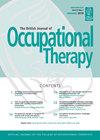在亚急性中风的实践中实施约束诱导运动疗法:中风幸存者和治疗师的经验和看法
IF 1.3
4区 医学
Q3 REHABILITATION
引用次数: 0
摘要
导言:约束诱导运动疗法已被证明对亚急性中风幸存者亚群有效,但尚未在英国广泛实施。本研究探讨了治疗师和中风幸存者对约束诱导运动疗法的看法和体验,并探讨了这些观点的不一致(不协调)和一致(协调)情况。方法:征得同意的职业治疗师(3 人)和物理治疗师(5 人)参加了焦点小组讨论。四名中风幸存者接受了约束诱导运动疗法前后的访谈。脑卒中幸存者选择并接受了以证据为基础的约束诱导运动疗法方案。对焦点小组和访谈录音进行了独立的专题分析。研究结果:确定了四个总体主题:参与约束诱导运动疗法的动机和决心;谁能受益;哪种方案;使约束诱导运动疗法可行。最后一个总主题包括五个分主题:疲劳和睡眠;疼痛;交通;需要支持;治疗师的培训、支持和指导。中风幸存者和治疗师对三个主题的看法截然不同。结论:参与研究的中风幸存者成功地进行了自我选择、以证据为基础的约束诱导运动疗法。所发现的促进因素和障碍应为未来制约诱导运动疗法方案的制定提供参考。治疗师和中风幸存者持有的截然不同的观点加强了在限制诱导运动疗法中进行合作交流和提供选择机会的必要性。本文章由计算机程序翻译,如有差异,请以英文原文为准。
Implementing constraint-induced movement therapy into practice in sub-acute stroke: Experiences and perceptions of stroke survivors and therapists
Introduction:Constraint-induced movement therapy has been shown to be effective in a sub-group of sub-acute stroke survivors but has not been widely implemented in the United Kingdom. This study explored therapist and stroke survivor perceptions and experiences of constraint-induced movement therapy and explored the non-agreement (incongruence) and agreement (congruence) of these perspectives.Method:Consenting occupational therapists ( n = 3) and physiotherapist ( n = 5) participated in a focus group discussion. Four-stroke survivors undertook pre- and post-constraint-induced movement therapy interviews. Stroke survivor participants selected and undertook an evidence-based constraint-induced movement therapy protocol. Focus groups and interview audio recordings were independently analysed thematically. Therapist and stroke survivor views were subsequently synthesised using meta-ethnographic principles.Findings:Four over-arching themes were identified: motivation and determination to participate in constraint-induced movement therapy; who benefits; which protocol; making constraint-induced movement therapy feasible. The final over-arching theme comprised five sub-themes: fatigue and sleep; pain; transport; need for support; training, support and mentorship for therapists. Stroke survivors and therapists held contrasting views on three themes.Conclusion:Participating stroke survivors successfully undertook a self-selected, evidence-based constraint-induced movement therapy protocol. The identified enablers and barriers should inform future constraint-induced movement therapy protocol development. The contrasting views held by therapists and stroke survivors reinforce the need for collaborative communication and opportunity for choice during constraint-induced movement therapy.
求助全文
通过发布文献求助,成功后即可免费获取论文全文。
去求助
来源期刊

British Journal of Occupational Therapy
REHABILITATION-
CiteScore
2.20
自引率
15.40%
发文量
81
审稿时长
6-12 weeks
期刊介绍:
British Journal of Occupational Therapy (BJOT) is the official journal of the Royal College of Occupational Therapists. Its purpose is to publish articles with international relevance that advance knowledge in research, practice, education, and management in occupational therapy. It is a monthly peer reviewed publication that disseminates evidence on the effectiveness, benefit, and value of occupational therapy so that occupational therapists, service users, and key stakeholders can make informed decisions. BJOT publishes research articles, reviews, practice analyses, opinion pieces, editorials, letters to the editor and book reviews. It also regularly publishes special issues on topics relevant to occupational therapy.
 求助内容:
求助内容: 应助结果提醒方式:
应助结果提醒方式:


